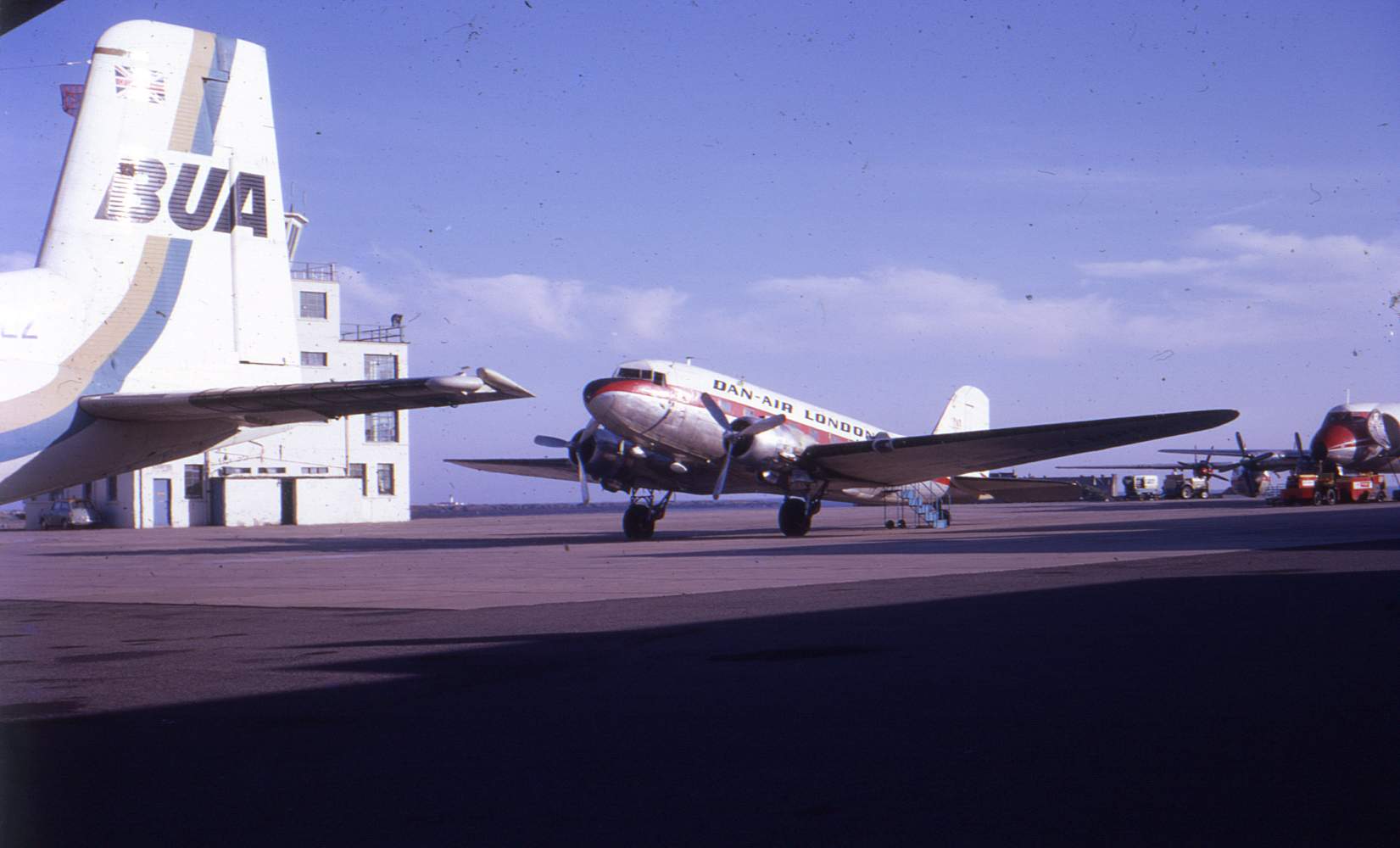Care & Maintenance to Renaissance
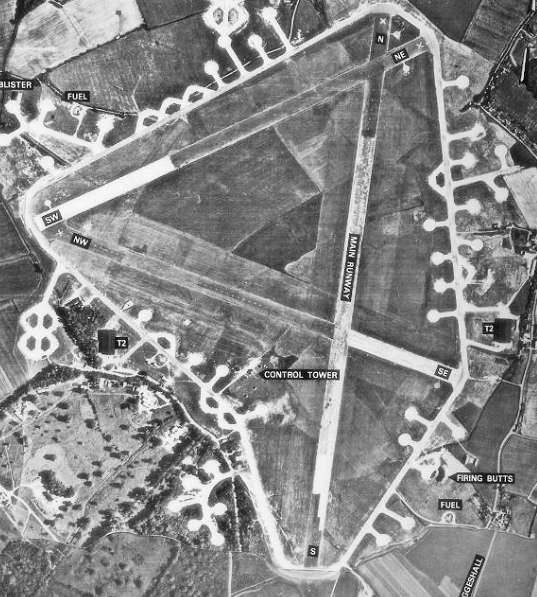
In 1939, only nine UK airfields had hard runways. The requirements of British and, from 1942, US forces led to the construction of 444 new airfields (24), twenty-four of which were in Essex. 1942, the year in which Earls Colne was built, saw the peak building effort with 125 airfields being commissioned – the equivalent of one being handed over every three days. At a cost, in 1942, of between 500,000 and one million pounds per site, the total bill for airfield construction ran to the staggering sum of 200 million pounds. By the end of the War, the UK of 1945 contained an astonishing 720 operational bases occupying 360,000 acres of land. This area comprised 105,000 acres which had been in use in 1940 plus a further 255,000 acres which had been requisitioned and paid for under the 1939 Compensation (Defence) Act. With the end of the War in Europe, many airfields became redundant and 1945 saw the passing of the Requisitioned Land and War Works Act to guide the return of property to farmers. The resale of de-requisitioned airfields was to be at a price adjusted to cover the cost of clearing the land and returning it to agricultural use.
With the departure of 296 and 297 Squadrons, Earls Colne was switched to a ‘care and maintenance’ basis. An RAF Maintenance Unit would have been moved onto the base to carry-out the day-to-day care of areas and buildings that were to be retained and the disposal of those which were no longer required. The photo above shows the airfield in July 1946 in its most developed state and prior to any return to agriculture. Pre-war Hams Farm had gone, Hungry Hall Farm and Marks Hall never recovered from military occupancy and both were eventually bulldozed (25) (26). Limited buildings remained at Newhouse and Brickhouse farms and the agricultural geography of the area can be said to have changed. New wartime crops such as sunflowers and opium poppies had added splashes of colour to the landscape -even twenty years later, isolated islets of deep purple could be seen patterning some fields of oats and barley around the village.
(24) Statistics from the Historic England report ‘9000 miles of concrete – A review of Second World War Temporary Airfields in England’ by Paul Francis, Richard Flagg and Graham Crisp. The title refers to Sir Archibald Sinclair’s statement in the House of Commons that the 160 million square yards of concrete laid as perimeter track and runways were the equivalent of a 30′ wide road stretching from London to Peking.
(25) Hungry Hall was demolished sometime in the late sixties/ early seventies having stood empty for many years. It was reputedly damaged by enemy bombing during WW2. Marks Hall was demolished in 1949 (see below).
(26) The Hall of Markshall Estate didn’t really survive military use. It has a fascinating history which is summarised below using information from the website www.markshall.org.uk. The property Mercheshala was mentioned in the Domesday Book of 1086. The Earl of Essex, Hugh de Montfort, had granted land to the family of Adelolf de Merc who had fought alongside William the Conqueror at the Battle of Hastings. In 1163, the land was officially granted to the de Merc family and the estate was named Merkshall. In 1605, the estate passed to Robert Honeywood who built the mansion Marks Hall. The Honeywoods sold-up in 1897 and the estate was purchased at auction by the wealthy Welsh MP Thomas Phillips Price. With a lifelong interest in ecology, Price established links with Kew Gardens and developed the forest and deer park. Although he bequeathed his estate to the State, Markshall passed to his wife when he died in 1932. The Government took it over anyway in 1941 to build the airfield, accommodation and headquarter the US Eighth and, subsequently, Ninth Air Forces. The wartime occupation damaged the fabric of the house so much that it was demolished in 1949. Worse was to follow when the Forestry Commission was granted rights to grow commercial conifers over much of the estate. Many historic oaks were felled but the Estate survived and a charitable trust was created in 1971 and, today, manages the arboretum and gardens.
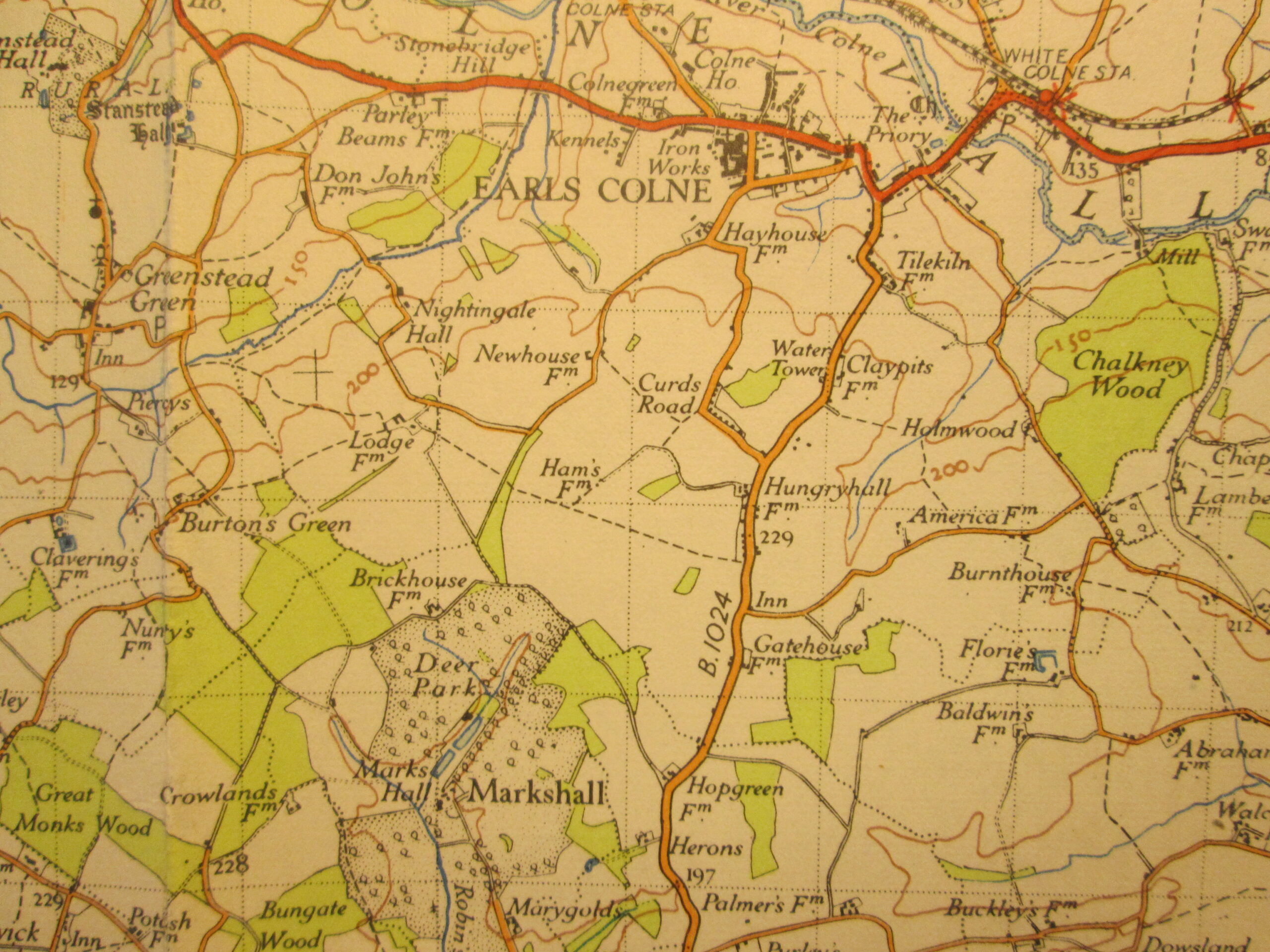
Manpower shortages had resulted from conscription and the RAF at Earls Colne had obligingly provided some extra hands at peak harvest times at farms such as Hopgreen. Conversely, the quotidien maintenance of the airfield grassland and corn field areas had been managed by a civilian contractor appointed by the Ministry of Agriculture’s local War Agricultural Committee. Ernest Doe and Company, originally a blacksmiths based near Maldon, had specialised in Fordson and Case tractors during the 1920s and 30s and were signed-up to provide tractors and Ransomes ploughs to Agricultural Committee farmers in Essex in the drive to maximise food production. Their expertise in farm machinery led them to being appointed as a contractor for maintaining and repairing some of the RAF’s airfield estates. Eventually, Ernest Doe would purchase the main Earls Colne airfield estate of 450 acres, a move which would determine the future land use and ownership to this day.
The Government’s Critchell Down Rules decreed that the original owner of requisitioned airfield land should be given the first option to repurchase acreage and buildings. Subsequently, superfluous real estate would be auctioned. Presumably, the previous farmers had little appetite for reacquiring their fields. Indeed, the landscape had changed greatly with the advent of the aerodrome: the pre-war fields, hedgerows and trees had been transformed into a large empty plain. Some old pear trees remained at Hungry Hall, a tree close to the air raid shelter behind the Hall but, otherwise, the only remaining trees were generally around the southern hangar area and along the margin with Markshall estate. A line of Aspen trees was planted in the 1960s from Curds Road towards Keepers Cottage to demarcate the break between the airfield lands and Bell’s Hayhouse Farm and some shelter trees were planted around the old Control Tower but the remainder of the land was like a prairie. Of course, the hedgeless, drained landscape was potentially what was needed for extensive grain cultivation and Does were the right people to utilise modern ploughing, seed-drilling and harvesting technology. However, the soils were heavy glacial boulder clays which were hard to work and the drainage had been optimised for the airfield’s requirements. Miles of drains had been installed with the aim of getting excess water off the runways and taxiways as fast as possible – not the same demands as those of agriculture. Drains at the side of the runways were piped and, although linked to large inspection chambers, access for maintenance was not as easy as with open ditches.
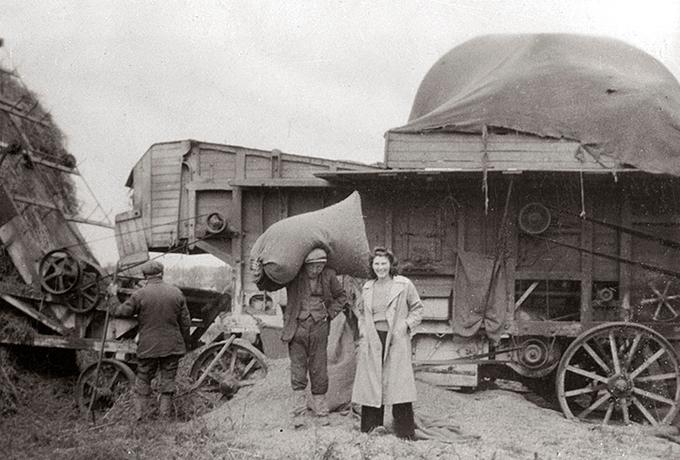
As the aerial photograph (head of section) shows, the area remaining as concrete in 1946 remained very large. While the runways and perimeter tracks offered useful access for farm vehicles, their width was far greater than necessary. The dispersal points also took up a lot of space and, by the time all wartime upgrades had been completed, there were many of them. As well as the original ‘frying pan’ design, larger ‘spectacle’ dispersals had been added. Each of the latter had four semi-circular hard standings which, unlike the ‘frying pans’, enabled aircraft to move past one another. There were also many single semi-circles of concrete used for parking the bombers. While unattractive for farming, the dispersal points were of great use to another resident of the airfield, the civil engineering contractors C.A. Blackwell. Branches of the Blackwell family owned farming and agricultural businesses around Earls Colne as well as the local bus company. Sid Blackwell had developed threshing and baling machines for use with Garret traction engines and his equipment was in use on the farms between Earls Colne and Coggeshall complementing what remained, in the forties and fifties, largely horse-drawn machinery. The younger family members included Chris Blackwell who had seen a future in earth-moving and planned to take advantage of war surplus Caterpillar tractors, graders and trucks to achieve his ambition. C.A.Blackwell (Contracts) Ltd was formed in 1956 and took over the eastern T2 hangar on the airfield. It afforded plenty of space for maintaining the large-scale construction equipment and the adjoining dispersal points and perimeter track were soon filled-up with redundant vehicles kept between contracts or for spares. Giant tyres, bulldozer blades, fuel tanks and bowsers, graders and caterpillar tracks were kept there. Britain’s first section of motorway, the Preston By-pass, was opened in 1958 and, with hundreds of miles of new roads being planned, the earthmoving business was a good place to be. C.A.Blackwell’s prospered in their original Earls Colne base and eventually worked on most major British infrastructure projects including the M3, M25, M4, Heathrow Terminal 5, High Speed Rail 1, the Nissan Car factory and wind power installations. Sixty years after the Company’s formation, Blackwell’s was sold to Hargreaves, the Durham open cast coal miner and transport company for just under 12 million pounds. They continue to operate from an Earls Colne office and now cover the country from depots at Tewkesbury, Wakefield, Leeds, Cardiff and Grangemouth.
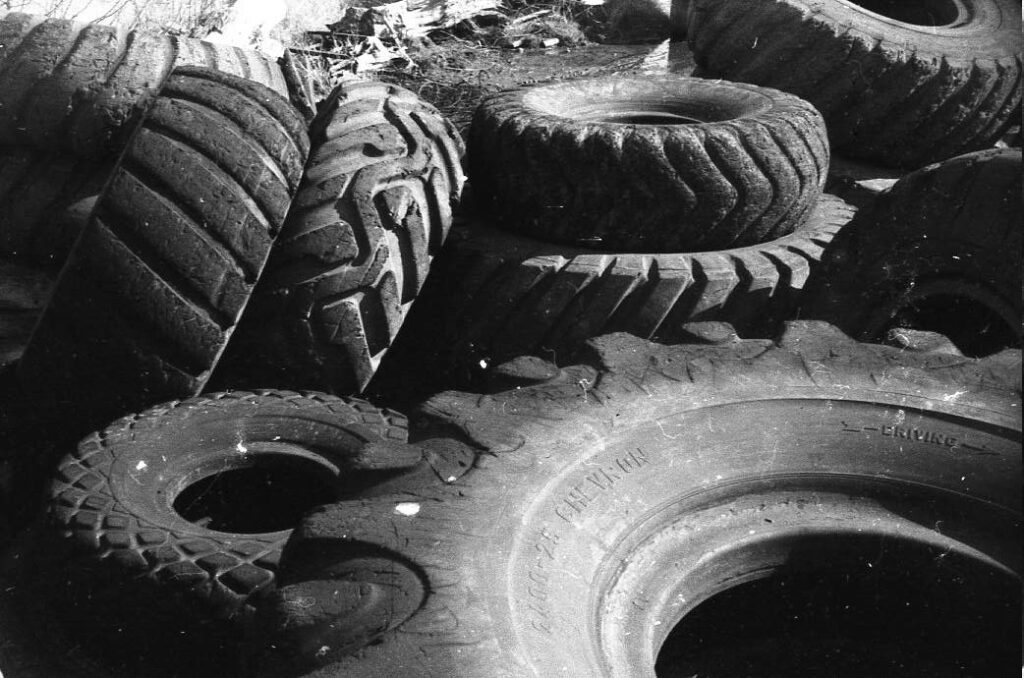
Meanwhile, the airfield kept a semi-military appearance during the 1950s with chain-link fencing in places and steel gates across many entry roads. ‘War Office -Keep Out’ signs threatened would-be visitors but, gradually, paths began to appear around the sides of gate posts and footpaths began to be used again. A further military user of the airfield appeared to be the Admiralty. Runway 12/30 was stacked with large quantities of anchors, chains, buoys and other maritime paraphernalia; the area aound the southern T2 hangar had huge stacks of grey, wooden ammunition boxes and Carley-type life rafts. Many of the latter were given away en masse in the 1970s and found their way to numerous local ponds and lakes.
The airfield was sold by public auction in 1955 and the Ernest Doe organisation continued to farm the 450 acres of Earls Colne airfield into the 1960s although the stony clay soils continued to create some difficulties. Potatoes and Sugar Beet were farmed as well as cereal crops and, sometimes, fields of nitrogen-fixing clover. The tractor-dealing side of Ernest Doe had, since 1957, been selling exclusively Ford tractors and, to help with heavy clay soils, produced their own version of the Fordson Super Major. Effectively, two tractors were bolted together in tandem, with a turntable inbetween, to produce a 100HP HP 4WD articulated beast which could cope with the sticky Essex conditions. Examples of the Doe Triple D were frequently seen ploughing the Earls Colne fields in the 1960s.
Although mostly down to Barley and other cereal crops, there remained some untidy zones of thorn bush and the large areas of weathering concrete. Where the full width of runway remained, the graveled, drained margins were often colonised by low, ground-cover plants such as stone crop, trefoil and weeds and flowers which sometimes bled into the corn. The area of airfield to the north of runway 07/25 was, in the mid sixties, a scrubby area with brambles and blackthorn bushes interspersed with odds and ends of military debris such as sections of rusted Pierced Steel Planking, bricks, concrete beams and blocks. The Ordnance Survey map of 1964 showed the ‘Airfield’ as such for the first time and the link between Newhouse Road and Nightingale Hall road was re-instated on both the ground and the map. Prior to this, as the aerial photo shows, the northern dispersal points had just been constructed right over the top of the road which had led to Hams Farm and Lodge Farm. It had remained possible to drive between the two road ends by turning through the gates (provided that they were unlocked) onto the airfield perimeter track. However, the construction of the brand new road was welcomed and a wire fence was inserted between it and the airfield perimeter.
NEW OWNER, NEW IDEAS.
Ernest Doe’s son-in-law, Eric Hobbs was an enterprising young farmer with property around Upminster in South Essex. His initial businesses had centred around fur farming, soft fruit and riding stables bit, in 1965, he had just sold one of his farms for a good price and was looking for a new venture. Ernest Doe thought that they had a buyer for the 450 acres of land at Earls Colne airfield but, at a late stage, the buyer pulled-out. It was suggested that Eric and his wife Margaret might like to buy the farm and a deal was struck (27).
Work had already commenced breaking-up the dispersal points and reducing perimeter tracks and runways to a viable width. The concrete runways at type A bomber airfields were usually laid in sections 15′ square which meant that there were ten sections to make up the width of a 50 yard/ 150′ runway. As a standard road would be under 30′ wide, eight of the sections could readily be torn-up to leave a perfectly workable farm road. Initially, the question might have been what should be done with all the rubble but, by the late 1950s, construction was apace in Britain with the New Town scheme, the improvement of roads and the impending introduction of the motorway system. Some of the rubble from the Blitz had been used to construct airfield runways and, in turn, the value of broken concrete aggregate from airfields was appreciated in constructing new towns and roadways north of London. The redundant airfields closest to the Capital were early donors to the Harlow New Town bypass but, with improvements to the A1 and the A12, the source of crushed concrete moved outwards into East Anglia. A single runway was capable of providing 100,000 tons of aggregate (24) which made the redundant RAF stations very popular with civil engineers. Earls Colne’s runways had benefited from post-Blitz London rubble delivered via the Colne Valley Railway along with local sand and gravel; they were now due to be broken-up and trucked locally to create the base for the new A12 dual carriageway.
(27) The Life Story of an Essex Boy, Eric Hobbs, Troubadour Publishing, 2013.
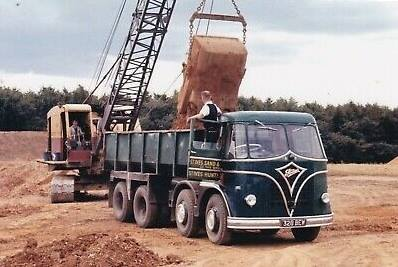
Eric Hobbs wasted no time in getting a deal in place to sell 50 acres of redundant concrete hardcore and the St.Ives Sand and Gravel Company moved-in during Autumn 1965 to break-up and crush runway acreage. In his autobiography, Eric Hobbs seems a little dissatisfied with the 30 pounds/ acre paid for the concrete (27) but other sources indicate that this amount was only paid in areas of high demand (24). St.Ives moved in a giant Ruston Bucyrus crane with a large steel wrecking ball. Sections of runway/ dispersal were broken-up by dropping the steel ball from height. The shards of concrete were scooped-up and deposited into a fleet of decrepit Foden, Seddon and Albion dump trucks. These battered vehicles then shuttled to the mobile concrete crushing plant which was set-up towards the north end of the main runway. The 2-3′ blocks fed into the crusher emerged as 2″ to 6″ diameter lumps suitable for road construction. This was then trucked away to the A12 site by slightly more roadworthy bulk tippers. The majority of the crushing work was completed by Spring 1967 leaving a few sections of runway at their original width but others cut right down to a narrow carriageway. The excavated area often remained scooped-out for some time until new top soil could be sourced. The sections of full-width runway remained important as they permitted the accasional landing of light aircraft on an ad hoc basis.
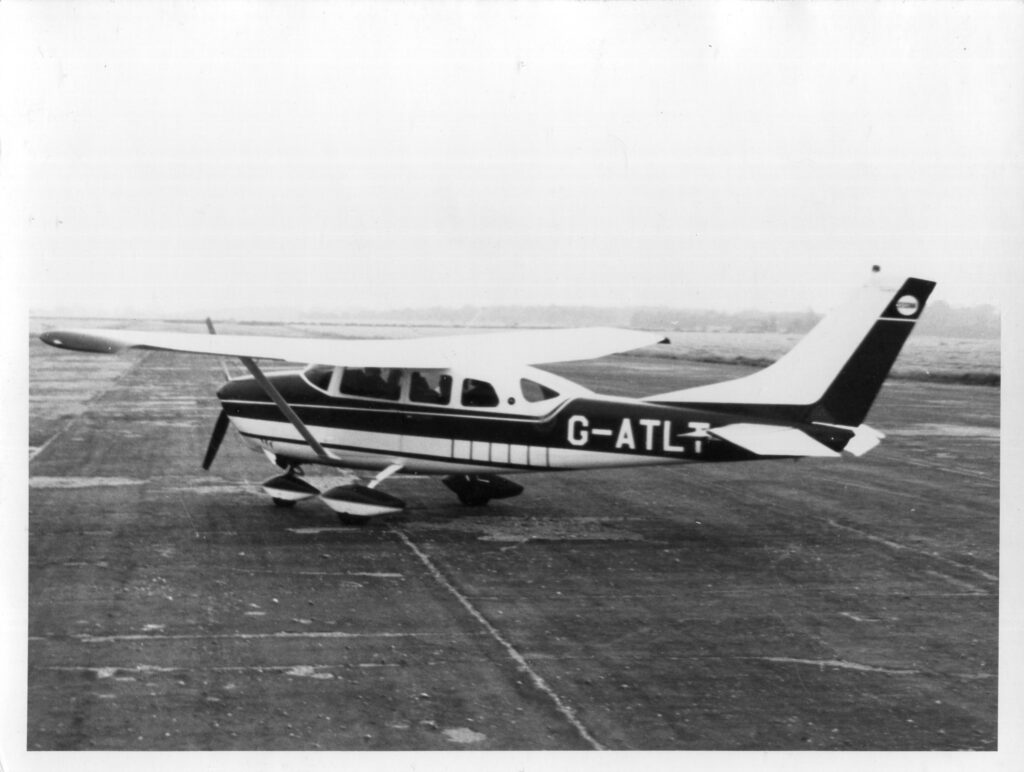
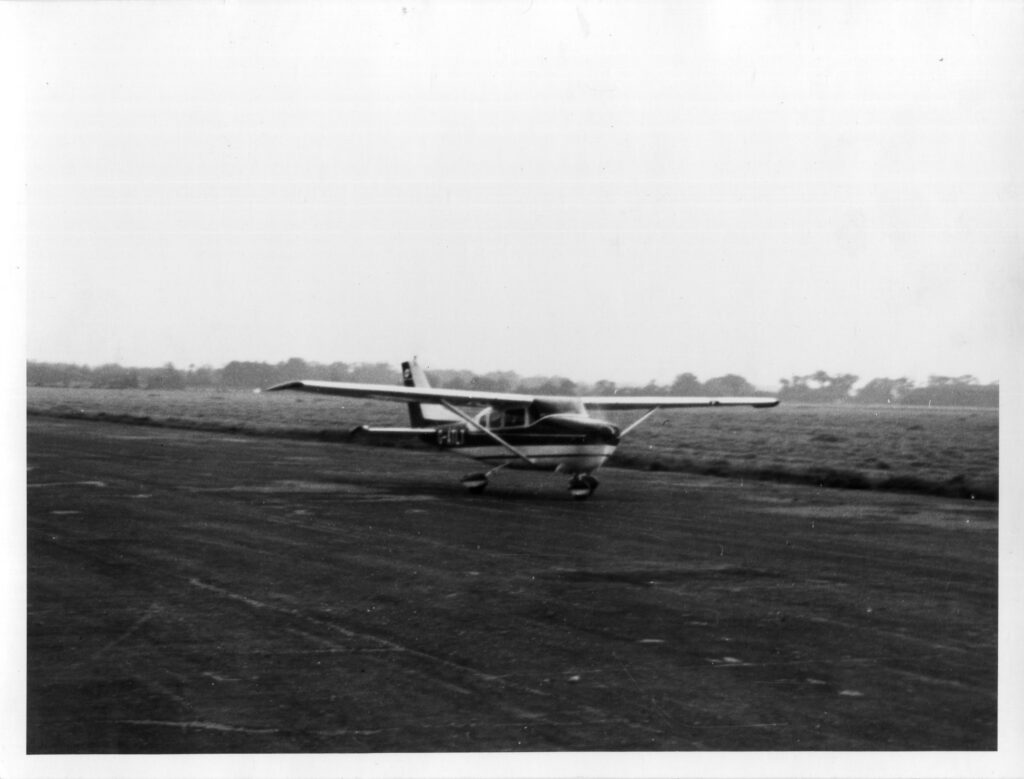
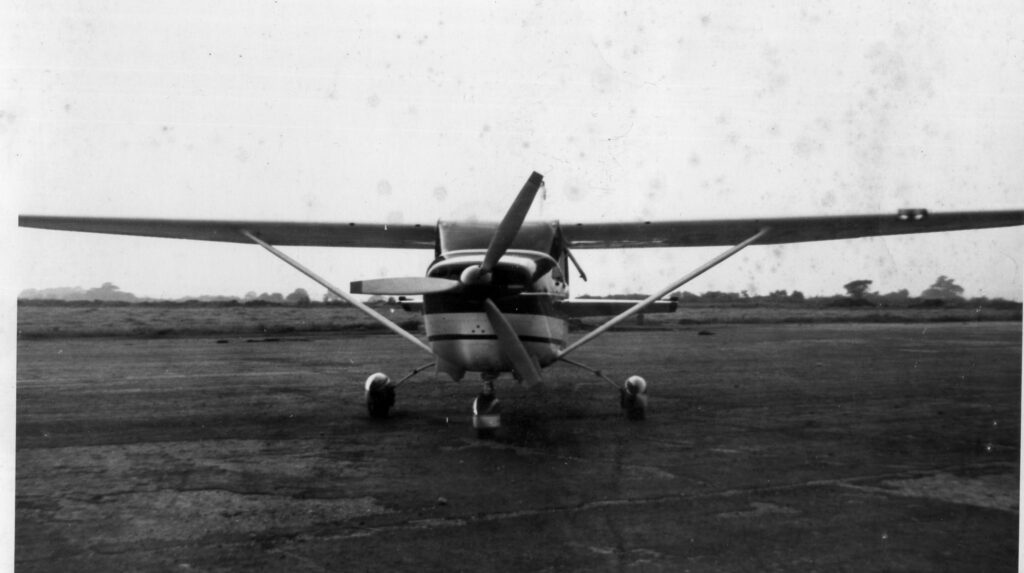
On a sunny evening in 1966, residents of Curds Road were surprised to see Cessna U206A G-ATLT make a few circuits of the airfield before touching down on main runway 01/19. There were some sections of this runway which remained at full-width and the hard surface remained in reasonable condition. After a short time, the Cessna taxied back to the south before turning and taking-off towards the village.
So far as is known, G-ATLT never returned to Earls Colne. The Super Skywagon had been built in 1965 and originally registered N4823F. Arriving in the UK, she was registered to Cessna agents Rogers Aviation at Bedford. By early 1970, ‘LT had moved to Norfolk, joining North Denes Aerodrome Ltd at Great Yarmouth. As well as flying pleasure trips, the Cessna also flew as a hack for Air Anglia from Norwich. She subsequently operated for parachuting organisations from Errol in Perthshire to her current owner, Skydive Jersey, in the Channel Islands.
Before the development of Earls Colne as a centre for light aviation, the late sixties and early seventies saw a gradual increase in visits by civil aircraft. Crop sprayers frequently worked in the area and Earls Colne featured a few visits during this period. One of the most interesting aircraft to drop-in was the Pilatus Turbo Porter PC-6 HB-FDH. Built in Switzerland in 1968 with the Pilatus serial number 658, the aircraft landed on the strip of perimeter track outside Eric Hobbs Honeywood farm house, close to the southern hangar. Given its outstanding STOL performance it could have landed just about anywhere!
The Turbo Porter was owned by the newly-incorporated company of Ciba Pilatus AG which had been formed with the intention of promoting their agricultural services across the World. HB-FDH was equipped with a very sophisticated spray system and, in May 1968, it traveled to the UK in the company of Pilatus Porter HB-FDP, the Pilatus demonstrator, which was fitted with passenger seats. The two Swiss-registered aircraft joined fellow Turbo Porter G-AWDS at Southend-based crop sprayers ADS Aerial. Ladislav (Laddie) Marmol, the Czech-born proprietor of ADS, had bought the British-registered Porter in February 1968 (it had previously been the 1966-constructed HB-FCK) and planned to use it for crop-spraying in Britain and the Sudan. G-AWDS was a popular airshow guest, performing very short take-offs and landings in Marmol’s capable hands. Eventually, it made it to the Sudan in June 1973 where it survived just over two months before being written-off. The Pilatus Porter demonstrator HB-FDP suffered a similar fate – it traveled to the Sudan in December 1973, possibly to replace G-AWDS and lasted just over six months before being wrecked.
Hence, of the three Pilatus Porters which graced the ADS Aerial Southend base in Spring 1968, HB-FDH, the aircraft which visited Earls Colne, was the only one to survive. While traveling the planet with Ciba Pilatus AG she had some close calls, including being flipped on her back by the prop wash from a US C 130 Hercules in Tehran in 1971 (28). However, upon departure from Ciba Pilatus in 1983, she became a parachutist transport and has remained so until today, currently flying with CERPS Maine & Val de Loire in Saumur as F-GOAG (29).
(28) Additional information from Noel Kinvig’s book Beyond the Cabbage Tree, an interesting view on the aerial spraying industry.
(29) Aircraft histories from www.PC-6.com
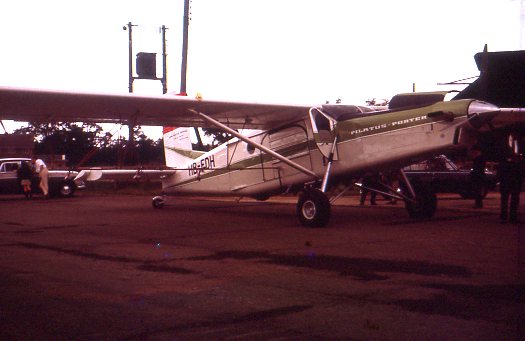
The 1960s and 1970s were a busy time for crop spraying contractors and Farm Aviation and ADS Aerial Pawnees were frequently seen spraying crops around Earls Colne along with the occasional Management Aviation helicopter.
Pawnee PA25 G-ASIY of ADS Aerial was a visitor and picked another section of runway/ perimeter track to set-down. Built in 1963 and delivered to Piper agents CSE Aviation of Kidlington in May of the same year, she had been sold to Laddie Marmol’s ADS Aerial by July ’63. Based at Southend, the ADS Piper fleet was painted in a surprisingly low key colour scheme: white with a red cheat line. Given the dangers inherent in crop spraying, it is surprising that ‘SIY is yet another Earls Colne visitor that survives into the 2020s as a sixty year old veteran! This is largely attributable to a 1984 change of career when ADS sold her on 4th July to the RAF Gliding and Soaring Association who based the Pawnee at Bicester/ RAF Halton for the next thirty-odd years. On 25th January 2015, G-ASIY moved on the the Kent Gliding Club at Challock, Ashford, and remains in use today – with a more exciting colour scheme!
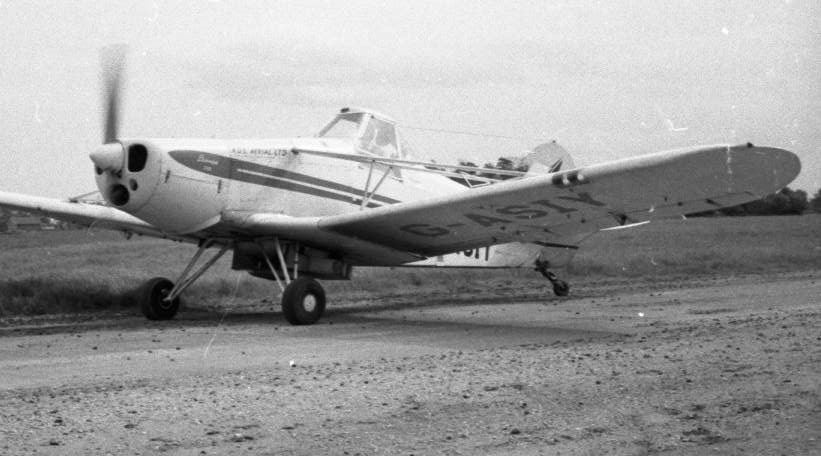
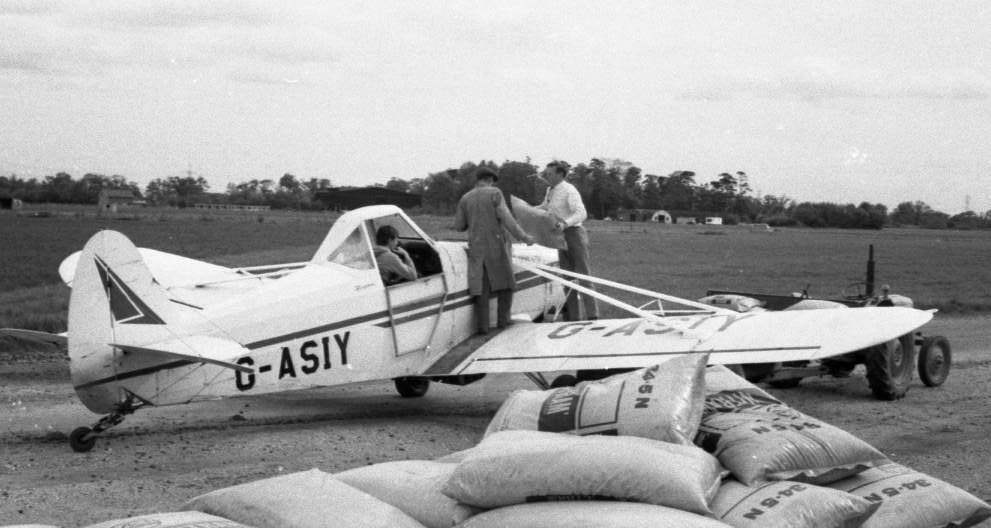
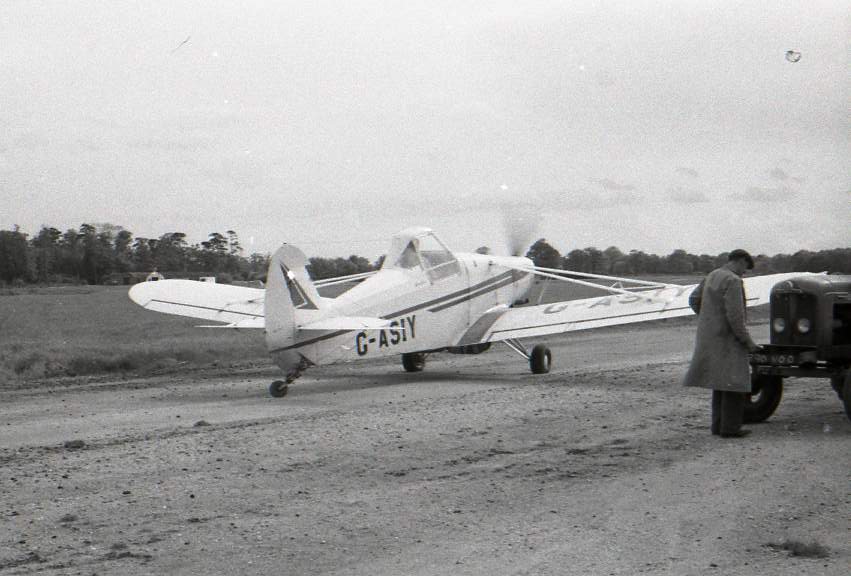
Another interesting visitor to Earls Colne in Spring 1971 was the Zlin aerobatic aircraft G-AWPG. The two pilots were practicing for the British Team entered into the World Aerobatic Championships and were both exceptionally skilled at putting the Zlin through a phenomenal series of aerobatic manoeuvres. They were also very well known in aviation circles – James Black and Neil Williams.
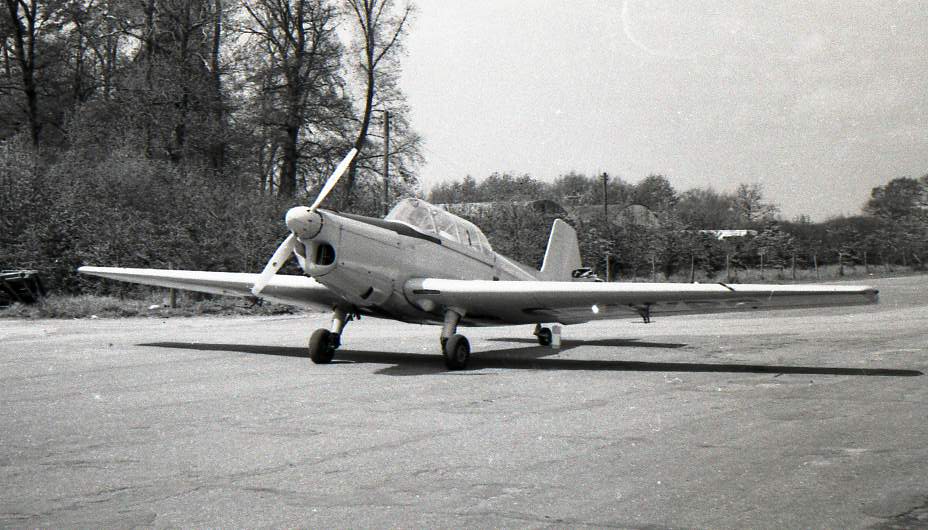
The Zlin was a frequent performer on the air show circuit and James Black used it as part of a ‘Zlin mirror’ flying formation where one aircraft flew inverted above the other during aerobatic routines. Neil Williams had been the Captain of the British Aerobatic Team since 1966 and was also well versed in Zlin stunts. In 1970, he was flying a Zlin at Hullavington when the lower wing spar boom fractured and the port wing began to fold-up. He flipped the aircraft into inverted flight, enabling the wing to be forced back into place. With only limited fuel available for inverted flying, he regained Hullavington airfield, descended to land and, at the last moment, flipped the Zlin back upright to touch-down. Fortunately, the Zlin antics at Earls Colne were dramatic but went entirely as planned.
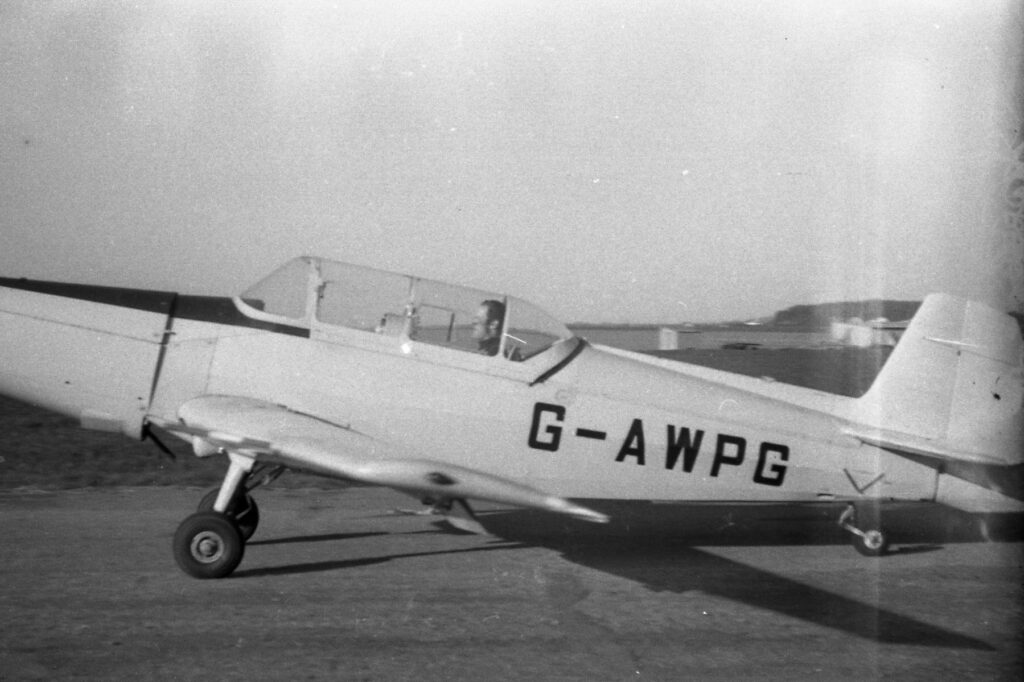
The Zlin visited Earls Colne on a couple of May weekends but practice was limited by the need to fly to Stansted to refuel. At the time, the provision of Avgas at Earls Colne was considered as Blackwells had a couple of old, yellow ex-USAF fuel bowsers stored in their compound. However, the tanks were no longer sufficiently clean or flake-free for aviation use – after all, you don’t want any fuel problems when flying tricky inverted manoeuvres!
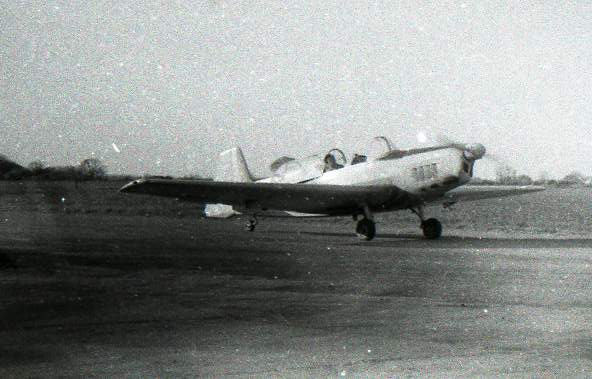
The practice must have been beneficial as, by 1974, the British team had gone on to win the European Aerobatic Championships and Neil Williams was known to Air Traffic Control by his call sign ‘Aerobat 1’. As detailed in the Miscellavia thread on Lancaster G-ASXX/ Just Jane, he also flew a huge variety of aircraft, both modern and historic, and was the pilot at the controls for every flight of ‘Just Jane’ following her arrival from Australia in 1965.
Although the Zlin didn’t return to Earls Colne after the Spring of 1971, there was a postscript in May of the following year: Neil Williams flew a Stampe as part of the Rothmans Aerobatic Team and on May 31st 1972 the three blue and gold biplanes flew over the airstrip. They were returning home from a display at the Suffolk Show in Sudbury. Over Earls Colne, #2 and #3 performed flick rolls, then, briefly, flew in a mirror formation. The fourth back-up Stampe followed a few seconds later rocking the wings energetically. Knowing the Rothmans Team, this might have just been joie de vivre , but it would be nice to think it was Neil Williams saying hello….
In December 1977, Neil Williams and his wife Lynn were killed when the CASA 2.111 he was ferrying from Cuatro Vientos in Spain to Blackbushe crashed in the Sierra de Guadarrama. Neil Williams, a natural pilot, July 10th 1934 – December 11th 1977.
Meanwhile, Earls Colne was to attract some frequent light plane visitors – enough to justify the tidying-up of runway facilities. On Saturday October 28th 1972, Piper Caribbean G-APXT arrived in the late afternoon and, after assessing wind speed and direction from local bonfire smoke, made a touch and go on Runway 07/25. Circling round, the smart little blue and white Piper approached from the east over Richard’s Grove and touched-down around 17:30. It probably landed on the newly-established grass strip which ran alongside the remaining concrete strip of Runway 07/25. The pilot parked on the hard section at the juncture of runways 07/25 and 01/19 and spoke to the airfield owner, Eric Hobbs. It was reported that they discussed the possibility of weekend visits from the Piper’s Stapleford Tawney base. Coincident with the visit, a car towing a glider trailer was also visiting the airfield and the occupants may have been discussing glider towing from Earls Colne. G-APXT took-off again as dusk gathered around 18:00.
The Piper was owned by McKenzie & Tapp Ltd, a manufacturer of tin boxes in Romford. The owners had purchased the aircraft in 1965 and kept it until 1983. More recent owners have converted the aircraft to tailwheel configuration by removing the nose wheel and reversing the undercarriage.Again, the aircraft survives into the 2020s having taken-up residence in Shropshire during 2016.
G-APXT returned on the morning of Saturday November 4th 1972, a fine but cold and windy day. Arriving from Stapleford Tawney, the Piper landed in a westerly direction on the grass strip before taxiing back to the eastern end. The pilot then proceeded to fish-out a tape measure and check the width of the concrete strip! G-APXT’s visit coincided with the arrival of another group which made use of Earls Colne airfield during the early 1970s: radio-controlled aircraft enthusiasts. The RC guys proceeded to fly their craft while the two Piper pilots chatted to airfield owner Eric Hobbs. G-APXT took-off shortly and headed away in a north-westerly direction.

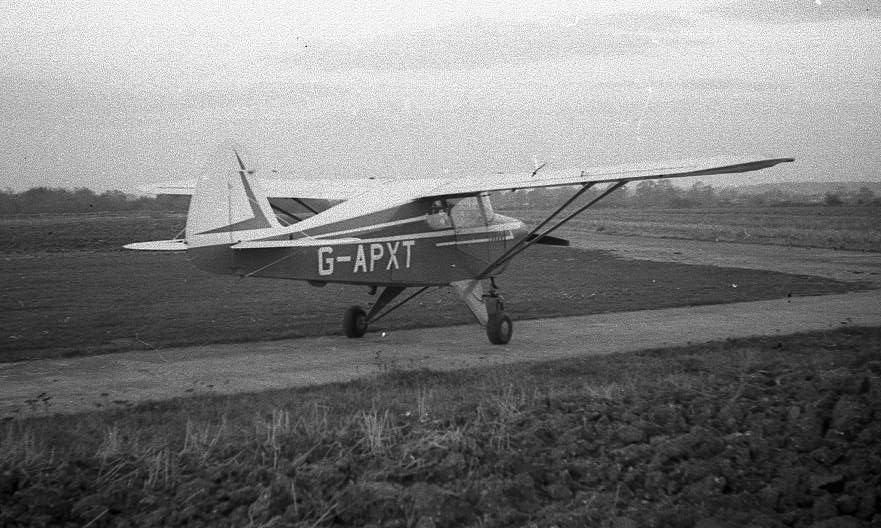
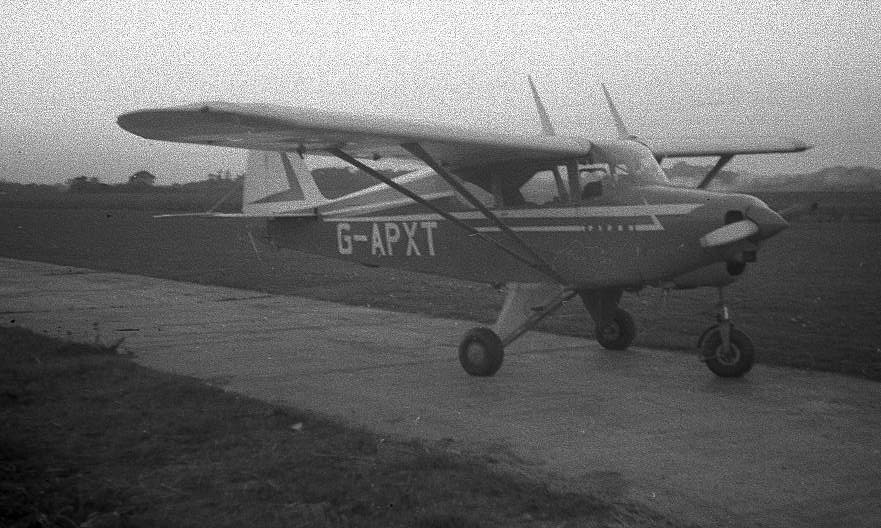
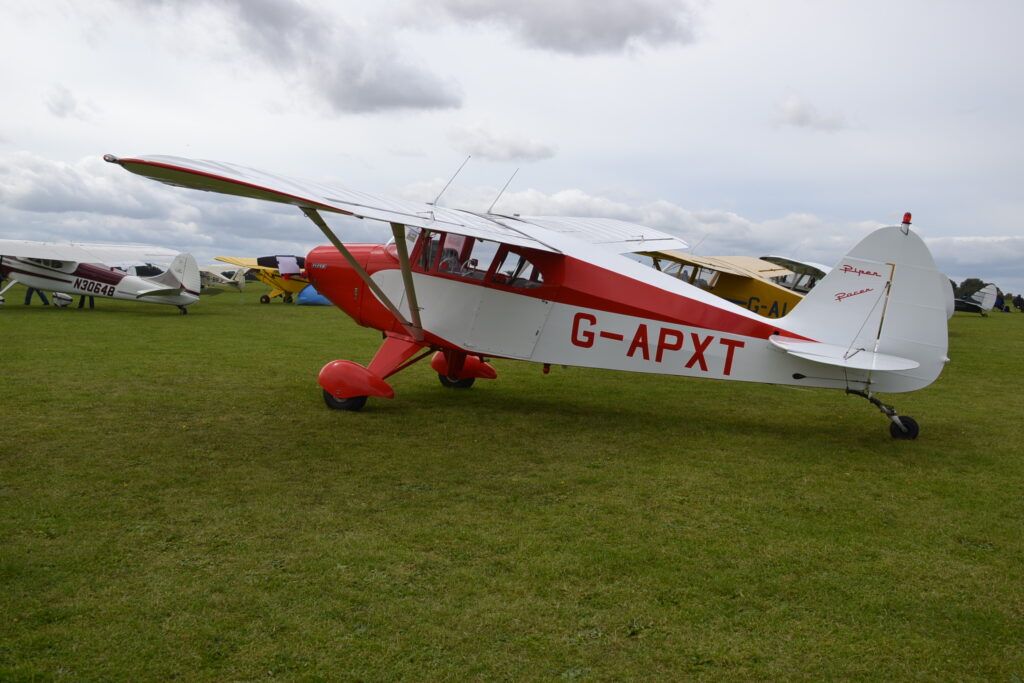
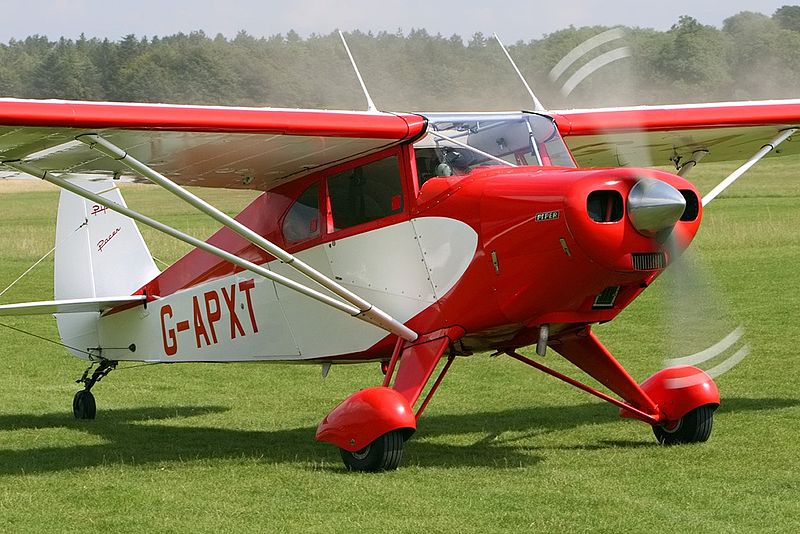
1972 also saw another important development in the revived aviation life at Earls Colne. The grass strip alongside runway 07/25 which welcomed the Piper Caribbean also enabled the landing of a larger aircraft – a twin-engined Piper Navajo.
G-AYFZ, a PA-31 310 Piper Navajo, was first noted landing on the morning of Tuesday July 25th 1972, although it may have visited earlier. The aircraft had been built in 1970 as N6771L and registered to Bayswater Services Ltd of Guernsey, Channel Islands, in June of the same year. It cost around 100,000 pounds new and Bayswater was probably a service company operating the Navajo on behalf of industrialist Arthur Evans. The crest of Evans Electroselenium Ltd, the company founded by Evans, certainly appeared on the Navajo’s fin and he seemed to be the main user of the aircraft. The reported annual 400 flying hours seems quite a lot for a single-user executive aircraft but it’s not known whether there were other charterers.
Arthur Evans had formed EEL in 1939 to exploit the use of selenium cells in medical and photographic equipment. The business proved highly lucrative, prompting the construction of a modern premises at Halstead, four miles from Earls Colne, and allowing Arthur Evans to move to Guernsey – possibly for tax purposes. The Company was sold to Corning Medical during 1973 and the frequent visits by G-AYFZ may have been linked to negotiations surrounding the sale. The general pattern for the visits was for the Navajo to arrive at Earls Colne around 10:00, dropping-off Mr Evans, before departing half an hour later, possibly for refuelling at Stansted.
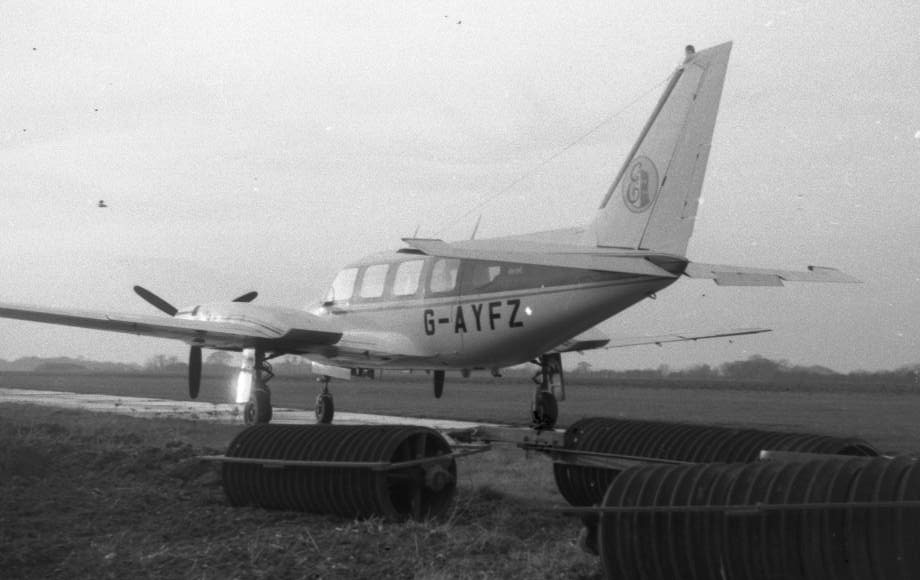
The Navajo returned on 28th August, arriving from the Channel Islands in the morning and departing from Earls Colne in the afternoon. Nine days later, she was back in the afternoon of September 6th, dropping-off passengers at 15:55 and departing to refuel at Stansted at 16:10. While in England during September 1972, the Navajo also made visits to Manchester and London interspersed with 10:00 morning landings at Earls Colne for a 30 minute visit on 27th and a day long stay on 29th of the month. There were further visits on 21st and 28th November 1972 with the aircraft remaining parked overnight on the hard section of the runway on the second date. The Navajo’s pilot had previously flown with Autair helicopters and Huntings and knew the hazards associated with grass strips and rough surfaces. G-AYFZ’s visits, however, continued into the winter of 1972: the early afternoon arrival on December 12th took advantage of warm and sunny weather, but the previous few days wet weather meant that the Piper landed on the grass strip in a big cloud of mud and water. G-AYFZ remained on field overnight and December 13th dawned cold and wet. It brightened-up in the afternoon and the pilot arrived around 13:30 to warm up the engines and prepare for take-off. The Evans party arrived at 15:00 bearing lighting accessories and a chandelier! The Navajo was parked on the hard strip of runway 07/25 and, once Mr Evans was comfortably seated in the co-pilot’s seat, the pilot ran-up the engines against the brakes until the nose was notably pitched-down. Conscious of the soggy reception on the grass strip, once the brakes were released the aircraft took-off expeditiously along the concrete strip. The width of the hard runway only left a couple of inches leeway on either side of the main wheels.
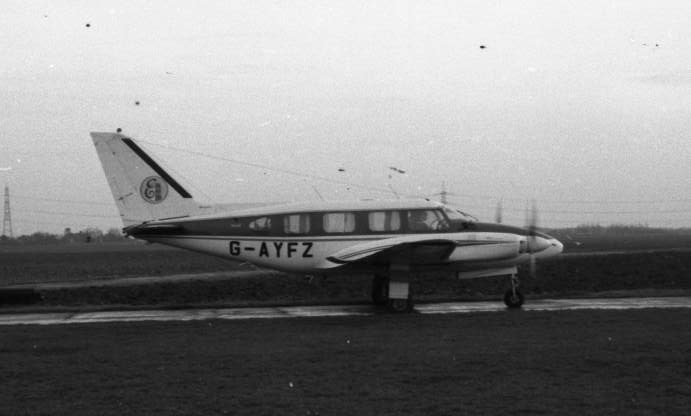
December weather notwithstanding, G-AYFZ returned on December 21st 1972 – indeed it seemed that she appeared the previous day but, owing to foggy weather in the afternoon, departed again without touching down.
The Navajo was back on 17th February and 12th April 1973, on both occasions arriving late morning/ early afternoon. However, sunnier climes appeared to have been calling and, three days later on 15th April, she was spotted in Malta and also visited Nice. A late morning arrival on May 1st took advantage of warm sunny Spring weather in East Anglia and the Piper remained overnight, departing at midday on 2nd. Two days later, the Navajo was back at Earls Colne in the afternoon and a tricky cross-wind belied the arrival of Spring. After just under an hour on the ground, the aircraft was airborne again, heading south for the Channel Islands and, reputedly, a trip to Naples. Visits became more frequent during May: on 15th of the months the Piper arrived mid-morning after the clearance of mist and fog. After remaining for a couple of days, G-AYFZ returned to Guernsey on 17th May. A mid-morning arrival on 30th May saw the disembarkation of one passenger before the Navajo performed an extensive engine run-up and departed heading west. Just a few days later, she was back for an 08:50 arrival on June 2nd. After a brief wait, 2 cars arrived, four or five passengers embarked and the aircraft departed. The next trip involved something new: G-AYFZ had to share the runway space with another aircraft, Piper Cherokee G-AZGM which was beginning to spend increasing amounts of time at Earls Colne. The Navajo departed the same evening, not returning to Earls Colne until June 11th.
Further visits continued throughout the summer of 1973. On June 20th, the Navajo made a low pass along the runway with the undercarriage down. After landing, the Evans aircraft remained on the ground for 2 days, departing June 22nd. Return visits to Earls Colne were made on July 17th to 18th, 24th, 27th and 31st plus August 6th and 8th-9th.
The Navajo’s visits to Earls Colne were reduced later into the seventies as Corning’s management took over the Halstead EEL plant. The Company has since moved through Corning ownership to Ciba Corning and, more recently, Diffusion System Ltd and Sherwood Scientific Ltd. It remains in business as a cutting edge manufacturer of scientific equipment. The Navajo was sold by Bayswater in November 1975 and passed through several Channel Islands owners before joining Air Luton on charter from 1983 to 1987. A return was then made to Jersey with hotelier Paul Doran who re-registered the aircraft G-OWLC in 1991. A new owner followed in 2000 with the sale to ‘Channel Airways’ of Guernsey and the Piper was de-registered in 2016. But she is still active….the de-registration from the UK register saw her added to the Guernsey register as 2-OWLC and she was noted in those colours in the Guernsey Aero Club hangar in September 2022.
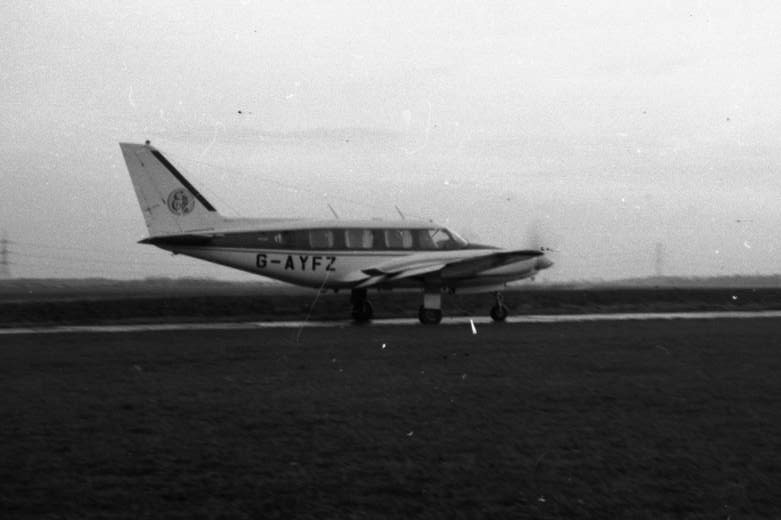
Spring 1973 brought a new round of light aircraft visitors. Rallye Club G-AZNJ arrived on 23rd February, a blustery Spring day which offered bouts of sunshine, rain, sleet and snow. Making an initial approach around 15:30, the gusty conditions precluded a landing and, after a brief go-around, the Rallye landed from east to west on the grass strip 07/25. After taxiing back to the eastern end, the pilot continued up the main runway 01/19 to the intersection with 12/ 30 where a generous area of concrete surface remained. The aircraft was turned into the wind, shut-down and secured for the night. The following morning, Saturday February 24th, the Rallye was taxiied back to the airstrip around 11:30 and the three pilots began a morning of practice circuits. Owned by D’Arcy Aviation, the Rallye is based at Tolleshunt D’Arcy airstrip. In order to avoid frequent trips to base to refuel during the training flights, the aircraft was topped-up with Avgas from a Land Rover-mounted 205 litre drum. Sunday February 25th was another busy day at the airstrip. the Rallye had gone home the previous evening but returned around 11:25 for a couple of approaches, a landing and a brief 15 minute stay. It had hardly disappeared over the horizon when another light plane, Jodel D120 G-AYLV, appeared and, after a prudent couple of trial approaches, landed on the strip. Based at Stapleford Tawney, the red, white and black Jodel belonged to four owners living in Essex and Hertfordshire. It had many controls/ gauges still labelled in French, demonstrating its previous identity as F-BNCG. The pilot for the day was a BBC cinematographer visiting friends at nearby Great Tey. Returning in the mid-afternoon, the Jodel took to the air and headed south. A further visit was made to Earls Colne on the afternoon of 29th April 1973.
G-AZNJ, according to the civil register, was owned by the Andrews Field flying group over at the old B-26 base at Braintree. The Air Britain register was more specific, giving the owners names as A.Gemmil, C.D.Harvey, D.S.McGregor and J.N.C.Milne. The Rallye visited Earls Colne again on 15th May 1973 and arrived for ‘circuits and bumps’ on 17th May. Earls Colne was probably a useful destination for short experience flights from Braintree and the Rallye was back again on 10th June and 3rd & 5th of July. By then, the crop-spraying season was looming and there were new potential visitors.
On 20th April 1973, Farm Aviation’s Pawnee G-AXBD made a very low pass over the strip, virtually touching wheels. However, it didn’t land and wasn’t seen again. Three years later it was written-off at Parsonage Farm, Norfolk.
ADS Aerial’s G-APVY arrived on 16th June and was involved in spraying/ top dressing activities from the Earls Colne strip during the evening and also the next day. It returned on the afternoon of June 20th, spraying fields to the east of Coggeshall Road well into the evening. After a last landing at 20:10, the Pawnee departed around 21:00. Further visits took place on 23rd June when the target fields were around Greenstead Green and on 25th June when fields around America Farm received attention. Landings were notably jaunty but take-offs reflected the load taken on board. After two visits, the Pawnee departed late into the evening again, around 21:10. Another couple of visits followed on 26th and 29th June 1973. G-APVY is interesting as it was the first Piper Pawnee to grace the British register back in May 1960. The, then, Piper Agents, Vigors Aviation, owned it, perhaps using it as a demonstrator, until 1962 when it was sold to ADS Aerial. It remained with them until December 1983 when it crossed the Irish Sea to join Michael Kirk’s KK Aviation at Ballymena. Withdrawn from use in 1987, the registration was cancelled in 1991.
Another light aircraft which made frequent visits to Earls Colne was the Cherokee G-AZGM which was first noted on May 18th 1973. It remained at Earls Colne, flying circuits every day until 21st May when it departed after making a low level beat-up of the strip. It arrived back late evening on 25th May and remained until the first week in June. It indulged in flying practice on 26th, 27th, 28th May and was still in residence when Evans’ Piper Navajo arrived on May 30th. Two aircraft on the strip at once! More flying followed every day from June 2nd to 5th and then it departed on the evening of June 7th after another couple of low passes. Returning on Saturday June 9th, it was flying on 10th and appeared to depart on 11th. Nonetheless, it was back on 17th, 18th, 20th, 22nd and 24th June and continued with a busy flying programme throughout July.
Piper Colt PA-22 G-ARNK made several circuits of the strip on the evening of July 5th and returned to take up residence between 13th and 20th of July. The dark blue and white Piper had been owned by Derek Golding of Golding Audio since 19th December 1972. When the Evans Navajo landed on July 30th, the Cherokee G-AZGM and the Piper Colt G-ARNK were both in residence. The tricycle-undercarriage PA-22 would become a regular site at Earls Colne over the years to come.
Hits: 170
